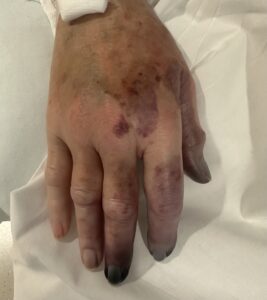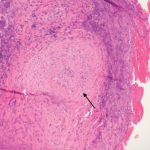Granulomatosis with polyangiitis (GPA) is a small vessel vasculitis associated with anti-neutrophil cytoplasmic antibodies (C-ANCA), specifically proteinase 3 (PR3) ANCA. GPA classically presents with multi-organ involvement. The first description of GPA defined a triad of features: 1) systemic necrotizing angiitis, 2) necrotizing inflammation of the respiratory tract and 3) necrotizing glomerulonephritis.1
Few cases of digital limb ischemia have been reported in patients with GPA.2-5 Based on a literature review, digital limb ischemia in patients with GPA has an estimated prevalence of <1%.2
We present a case of GPA in which the primary complaint was digital limb ischemia.
Case
A 71-year-old woman, with a past medical history significant for migraines but no smoking history, presented initially with violaceous discoloration of her thumb and first two fingers on her right hand and fingers 2–5 on her left hand (see Figures 1). She reported that she’d been having pain, which was exacerbated with movement, for the previous week.
She underwent evaluation for digital limb ischemia, which was presumed secondary to vessel thrombosis. She was treated with a heparin, antiplatelet agent and hydroxyurea; however, this did not improve her ischemia. The patient then underwent thrombolysis of both arms, but her digital ischemia continued to progress.
A bone marrow biopsy, computed tomography angiography (CTA) of her chest and her renal function were all normal. Her rheumatoid factor and sedimentation rate were elevated, and she was positive for C-ANCA. The patient was then transferred to our facility for a rheumatology evaluation.

FIGURE 1B: Violaceous discoloration is present on the thumb and first two fingers of the right hand (i.e., digits 1–3) and four fingers on the left hand (i.e., digits 2–4). (Click to enlarge.)
Upon further evaluation, the patient reported that she’d had a sinus infection one month before presenting to the hospital. Additionally, she had developed new onset hemoptysis and hematuria the day before, along with left foot drop consistent with mononeuritis multiplex. With this additional information, the most likely differential diagnoses included cryoglobulinemic vasculitis, granulomatosis with polyangiitis, Raynaud’s syndrome, thromboangiitis obliterans and rheumatoid arthritis.
At this time, additional rheumatologic serologies were obtained, including myeloperoxidase (MPO), PR3, beta2-glycoprotein panel, complement levels, SPEP, ANA, glomerular basement membrane IgG, protein electrophoresis (see Table 1).
Laboratory results showed an elevated C-ANCA and PR3 and a protein normalized to creatinine ratio of 1,143 mg/g. Chest X-ray results showed increased airspace changes in both lungs, extending into the lower lobes. The rest of her serological work up was unremarkable.



